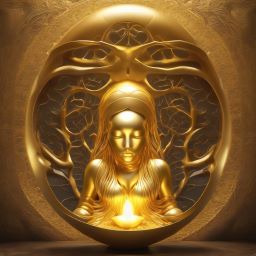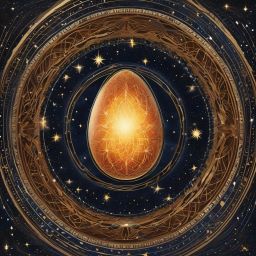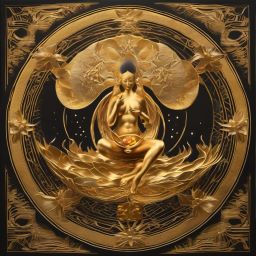Hiranyagarbha Sukta Meaning: Vedic Insights & Significance
Discover the profound meaning of Hiranyagarbha Sukta and gain spiritual interpretations, critical aspects, symbols and insights from ancient Vedic scriptures.
DIVINE
I. Understanding Vedic Literature and the Hiranyagarbha Sukta
Introduction to Vedic Literature
Vedic literature is a collection of ancient Indian texts foundational to Hindu philosophy and culture. These texts include hymns, rituals, and philosophical teachings. The Vedas, the oldest texts, are essential for understanding early Indian thought. They reveal the beliefs and practices of ancient society.
The Importance of Vedic Literature
1. Cultural Heritage: Vedic literature is a treasure of ancient wisdom. It provides insights into the history and culture of early India.
2. Philosophical Depth: The texts explore profound philosophical questions, addressing the nature of existence, the universe, and the divine.
3. Spiritual Teachings: These writings guide spiritual practice and ethical living.
The Hiranyagarbha Sukta
The Hiranyagarbha Sukta is a hymn found in the Rigveda. The Rigveda is one of the four Vedas and contains many hymns dedicated to various deities. The Hiranyagarbha Sukta is unique for several reasons:
1. Meaning of Hiranyagarbha: The term "Hiranyagarbha" translates to "golden womb" or "Golden Egg." It symbolises the origin of the universe.
2. Creation Myth: The hymn describes the creation process. It emphasises cosmic unity and the interconnectedness of all life.
3. Spiritual Insight: The Sukta invites readers to reflect on the nature of reality and existence. It inspires a sense of wonder about the universe.
Significance of Understanding Ancient Texts
Studying ancient texts like the Hiranyagarbha Sukta is crucial for several reasons:
1. Connecting with the Past: These texts help us connect with our cultural and spiritual roots, linking us to generations before us.
2. Lessons for Today: The wisdom contained in these texts can still be relevant. They provide insights into modern challenges and dilemmas.
3. Cultural Appreciation: Understanding these writings enhances our appreciation of diverse cultures and traditions. It fosters respect for different worldviews.
Vedic literature, particularly the Hiranyagarbha Sukta, is vital in understanding ancient Indian philosophy. These texts offer valuable insights into life, creation, and morality. By studying them, we can better appreciate our shared human heritage. Let us engage with these ancient hymns, allowing them to inspire and enlighten us today.
II. The Context of Hiranyagarbha Sukta
Overview of the Rigveda
The Rigveda is one of the oldest sacred texts in the world. It is part of Vedic literature, a collection of ancient Sanskrit texts. The Rigveda consists of hymns that praise various deities. It plays a crucial role in understanding early Indian religious practices and beliefs.
Importance of the Rigveda
1. Foundation of Hinduism: The Rigveda is foundational to Hindu philosophy and spirituality.
2. Cultural Insights: The hymns provide insights into Vedic society's daily life, rituals, and values.
3. Early Text: One of the oldest texts, it offers a glimpse into ancient thought and language.
Historical and Cultural Background of the Vedic Period
The Vedic period stretches from around 1500 BCE to 500 BCE. During this time, the early Indo-Aryans settled in the Indian subcontinent. This era saw the development of language, religion, and social structures.
Key Features of the Vedic Period
1. Social Structure: Society was organised into classes known as varnas. These included priests (Brahmins), warriors (Kshatriyas), traders (Vaishyas), and labourers (Shudras).
2. Ritual Practices: Rituals were central to Vedic life. They often involved sacrifices to please the gods.
3. Philosophical Development: Many philosophical ideas emerged during this time. Concepts of dharma (duty), karma (action), and moksha (liberation) were explored.
Structure and Composition of Rigveda Hymns
The hymns of the Rigveda are composed in a structured format. Each hymn, or "sukta," typically consists of multiple stanzas. The language used is poetic and rich in imagery.
Critical Components of Rigveda Hymns
1. Meter: Each hymn follows a specific metrical pattern. Standard meters include "Gayatri" and "Trishtubh."
2. Invocation: Hymns often begin with an invocation to a deity, expressing reverence and requests for blessings.
3. Imagery: The use of vivid images and metaphors is prominent. This enhances the meaning and emotional depth of the hymns.
Themes in the Rigveda
1. Nature and Creation: Many hymns explore themes of nature and the cosmos.
2. Deities: The Rigveda introduces numerous deities representing different aspects of life and the universe.
3. Rituals and Sacrifices: Many hymns detail rituals meant to honour the gods and ensure prosperity.
The Hiranyagarbha Sukta is rooted in the broader context of the Rigveda. Understanding the Rigveda, its historical background, and its structure helps us appreciate the hymn's deeper meanings. These elements provide essential insights into the beliefs and practices of the Vedic period. By studying this context, we can grasp the significance of ancient hymns like the Hiranyagarbha Sukta in human thought and spirituality.
III. Understanding the Hiranyagarbha Sukta
Meaning of "Hiranyagarbha" (Golden Womb)
The term "Hiranyagarbha" translates to "golden womb" or "golden egg." This powerful symbol represents the universe's origin and suggests that all creation emerges from this primordial source.
Significance of the Concept
1. Cosmic Origin: Hiranyagarbha highlights a divine beginning of all things.
2. Unity of Existence: It emphasises the interconnectedness of all life. Every being comes from this single source.
3. Spiritual Depth: The golden womb represents nurturing and creation, embodying the divine potential within the cosmos.
Overview of the Hiranyagarbha Sukta
The Hiranyagarbha Sukta is found in the Rigveda, specifically in the tenth mandala. It is one of the most important hymns in the text.
Placement in the Rigveda
1. Location: The Sukta is in the Rigveda's 10th book (Mandala).
2. Significance: As part of the Rigveda, it is vital among other primary hymns. It reflects deep philosophical thought.
Key Themes and Messages Conveyed Through the Sukta
The Hiranyagarbha Sukta explores several profound themes. Each theme contributes to its overall message.
Prominent Themes
1. Creation: The hymn describes the creation process and the universe's birth.
2. Divine Consciousness: It presents the idea of a universal consciousness that governs all.
3. Search for Truth: The Sukta encourages seekers to discover the nature of reality and existence.
Symbolism and Imagery in the Sukta
The Hiranyagarbha Sukta employs rich symbolism and vivid imagery. These elements enhance its meanings and themes.
Key Symbols and Images
1. Golden Womb: Represents the source of creation, fertility, and nurture.
2. Light and Darkness: Symbolises knowledge versus ignorance, highlighting the pursuit of enlightenment.
3. The Cosmic Egg: Reflects the idea of the universe as a dynamic entity born from a singular source.
Imagery Used
1. Nature Imagery: The hymn uses images of nature to illustrate creation, including fire, light, and water.
2. Cosmic Imagery: References to the heavens and celestial bodies show the grandeur of the universe.
Understanding the Hiranyagarbha Sukta allows us to appreciate its significance in Vedic literature. The concepts of the golden womb, the themes of creation, and the vivid imagery all contribute to its depth. This Sukta provides insights into ancient beliefs and inspires readers to reflect on their place in the cosmos. Through it, we connect with a timeless quest for knowledge and understanding.
IV. Spiritual Interpretations of the Hiranyagarbha Sukta
Interpretations by Ancient Scholars and Philosophers
Various ancient scholars and philosophers have interpreted the Hiranyagarbha Sukta. Their perspectives provide valuable insights into the text's deeper meanings.
Prominent Scholars and Their Views
1. Adi Shankaracharya: He saw Hiranyagarbha as a reflection of Brahman, the ultimate reality. For him, it symbolises the essence of consciousness.
2. Madhva emphasised the distinction between the individual soul (Atman) and the cosmic womb. He viewed this hymn as a celebration of divine creation.
3. Yaska: The ancient grammarian and philosopher interpreted it as a source of all beings. He believed that Hiranyagarbha represents the manifest universe.
Hiranyagarbha as a Symbol of Creation
The term "Hiranyagarbha" holds deep significance as a symbol of creation. It suggests that all things originate from a single source.
Key Aspects
1. Cosmic Womb: This womb represents the nurturing aspect of the universe, where all creation is conceived.
2. Cycle of Life: The Hiranyagarbha signifies birth, life, death, and rebirth. It highlights the constant flow of existence.
3. Unity of Creation: This symbol conveys that everything in the universe is interconnected.
The Sukta's Role in Vedantic Philosophy
The Hiranyagarbha Sukta plays a significant role in Vedantic philosophy. Vedanta seeks to understand the relationship between the individual soul and the cosmic reality.
Key Contributions to Vedanta
1. Unity of Atman and Brahman: The Sukta supports the idea that the individual soul (Atman) is one with the universal spirit (Brahman).
2. Cosmic Consciousness: The hymn emphasises a cosmic consciousness that pervades all existence. This awareness is seen as the source of all knowledge.
3. Path to Liberation: Understanding the concepts in the Hiranyagarbha Sukta can lead individuals on their spiritual journey. It encourages self-realisation and the attainment of moksha (liberation).
The spiritual interpretations of the Hiranyagarbha Sukta are rich and varied. Ancient scholars have offered insights that connect the hymn to broader philosophical ideas. Understanding this Sukta as a symbol of creation and its role in Vedantic philosophy deepens our appreciation of ancient Indian thought. It encourages seekers to explore their relationship with the universe and pursue higher knowledge.
V. Significance of the Hiranyagarbha Sukta in Modern Times
Relevance of Ancient Hymns in Today's Spiritual Practices
Ancient hymns remain relevant in today's spiritual landscape. They provide wisdom and guidance for modern seekers.
Key Aspects of Relevance
1. Timeless Wisdom: The teachings of the Hiranyagarbha Sukta offer insights into life and existence that are untouched by time.
2. Spiritual Connection: Many people use Vedic hymns in their prayers and rituals, fostering a deep spiritual connection.
3. Guidance for Meditation: Hymns like the Hiranyagarbha Sukta serve as focal points for meditation. They help seekers focus their thoughts and intentions.
Hiranyagarbha Sukta's Influence on Modern Spiritual Thought
The Hiranyagarbha Sukta significantly influences contemporary spiritual movements. Its themes resonate with many modern philosophies.
Modern Interpretations
1. Holistic View of Existence: The hymn's emphasis on cosmic unity supports holistic perspectives in modern spirituality.
2. Interconnectedness: Modern thought often highlights the interconnectedness of all beings. The Hiranyagarbha Sukta deeply reflects this idea.
3. Encouragement of Self-Discovery: The Sukta encourages individuals to seek their true nature and understand their place in the universe.
Insights into Universal Creation and Human Existence
The Hiranyagarbha Sukta offers profound insights into creation and existence. These insights are relevant for understanding human life and the universe today.
Important Insights
1. Unity of Creation: The hymn suggests that all life forms emerge from a single source. This concept of unity can inspire respect for all life.
2. Nature of Reality: It encourages seekers to explore the nature of reality. Understanding this nature leads to greater awareness.
3. Purpose of Life: The Sukta highlights that every being has a purpose. Recognising this can guide individuals toward meaningful lives.
The Hiranyagarbha Sukta holds significant relevance in modern spiritual practices. Its teachings continue to inspire and influence spiritual thought today. By providing insights into universal creation and human existence, this ancient hymn remains a valuable guide for seekers. Engaging with the Hiranyagarbha Sukta can enrich spiritual journeys and deepen understanding of life.
VI. Conclusion
Recap of Key Points Discussed
Throughout this article, we explored many vital aspects of the Hiranyagarbha Sukta. Here are the main points:
1. Meaning and Significance: "Hiranyagarbha" means "golden womb," symbolising the universe's origin.
2. Historical Context: We reviewed the Sukta's place in the Rigveda and its importance in ancient Indian literature.
3. Spiritual Interpretations: Scholars and philosophers interpret the hymn in various ways, emphasising its cosmic significance.
4. Modern Relevance: The teachings of this hymn still resonate with today's spiritual practices and philosophies.
5. Universal Insights: It provides profound lessons about creation, human existence, and interconnectedness.
The Enduring Legacy and Wisdom of Hiranyagarbha Sukta
The Hiranyagarbha Sukta holds an enduring legacy in spiritual and philosophical realms. Its wisdom transcends time and culture.
Critical Aspects of Its Legacy
1. Timelessness: The themes of unity and creation remain relevant across ages.
2. Inspiration: The Sukta inspires spiritual seekers, encouraging exploration of one's true nature.
3. Cultural Heritage: It is a crucial part of Indian heritage, illustrating the depth of Vedic thought.
In summary, the Hiranyagarbha Sukta is more than just an ancient hymn. It is a source of profound wisdom that encourages us to reflect on our place in the universe. Its teachings about creation and existence inspire both ancient and modern spiritual practices. Embracing the insights of this Sukta can transform our understanding of life and our connection to each other and the cosmos.
VII. Frequently Asked Questions (FAQs) About the Hiranyagarbha Sukta
1. What is the Hiranyagarbha Sukta?
The Hiranyagarbha Sukta is a hymn in the Rigveda, one of India's ancient sacred texts. This hymn explores the idea of the universe's golden embryo, representing the creation process and the essence of life itself.
2. What is the significance of Hiranyagarbha in Vedic texts?
Hiranyagarbha means "Golden Womb." It is a central symbol in Vedic literature. This symbol represents the source of creation and the universe. It highlights the interconnectedness of all life and the divine nature within creation.
3. How is Hiranyagarbha Sukta relevant today?
The Hiranyagarbha Sukta offers timeless insights into cosmology and existence. Its themes resonate with many contemporary spiritual beliefs. The hymn encourages people to reflect on their place in the universe. It inspires a deeper understanding of life's purpose and our connection to each other.
4. Where can I find the Hiranyagarbha Sukta?
The Hiranyagarbha Sukta is part of the Rigveda. This text is one of the most important sacred writings in the Hindu tradition. Many translations and interpretations of the Rigveda are available today. Readers can explore these versions to gain a better understanding of the Sukta.





